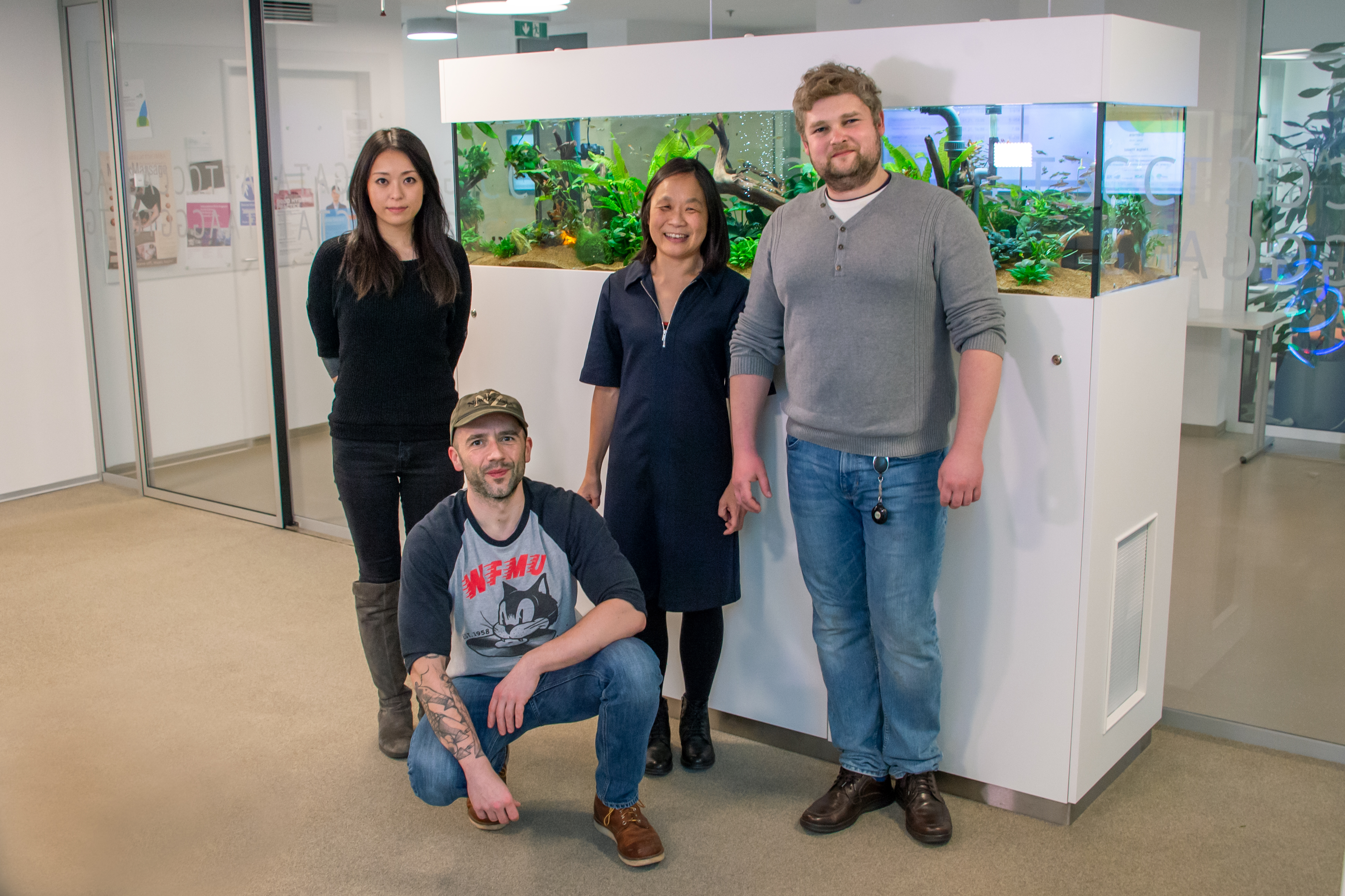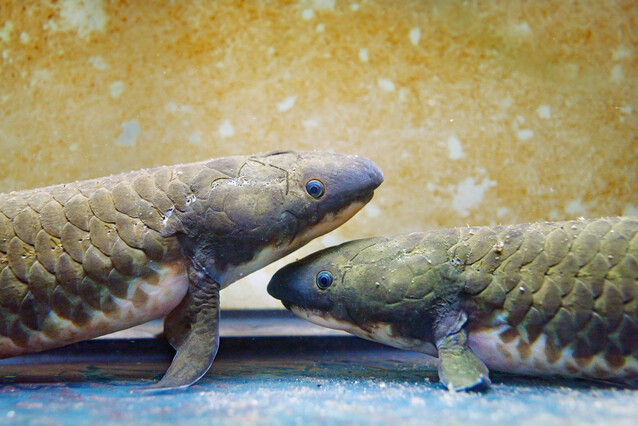Record-breaking lungfish genome reveals how vertebrates conquered land
380 million years ago, fish started to crawl out of the water to colonise land. The Australian lungfish – an endangered, air-breathing fish – is one of the few living relatives of these first land explorers. A team of researchers sequenced its giant genome for the first time, unveiling the species’ unique evolutionary history and striking similarities to land-dwelling vertebrates. The study, published in the journal "Nature", sets a record for the largest animal genome ever sequenced.
The Australian lungfish (Neoceratodus forsteri) dwells in slow-flowing rivers and still waters of Australia. Its peculiar body, resembling an impossible cross between a fish and a newt, led its 19th century discoverers to wrongly classify it as an amphibian. We now know that the lungfish belongs to the lobe-finned fish, an archaic group of aquatic animals that gave rise to all land vertebrates, including humans.
Video: vertebrate's conquest of land
We use a YouTube plugin to display social media content on this page, which places requests to YouTube servers. These requests make your IP address visible to YouTube, who may use it in accordance with their data privacy policy. Please agree to make the YouTube video visible. You can find more information in our privacy settings.
Accept
Before aquatic vertebrates first set fin on land in the late Devonian, they developed a whole suite of traits to survive out in the open. Strong, articulated limbs, a good sense of smell, and lungs are but a few examples. How these adaptations reflected on the genome of the first land-dwelling fish remains unclear.
For the first time, scientists have pieced together the DNA sequence of the Australian lungfish to chromosome lengths, bringing to light the largest animal genome known to science, and some of its ancestral secrets. This collaboration includes scientists from the Research Institute of Molecular Pathology (IMP), and the Universities of Vienna, Konstanz, Würzburg, and Hamburg.
Go big or go home: the largest genome ever sequenced
Before sequencing machines can decode the billions of base pairs in a genome, they break the overall sequence into tens of millions of short pieces. Scientists then use sophisticated computer algorithms to stitch the fragments back together, analysing the ends of each piece to see where it fits best.
The task proves particularly tricky with large genomes, as they tend to contain many copies of the same DNA fragments – or repetitive elements – that make the genome look like an incredibly complex puzzle with a very homogeneous pattern. Sequencing, assembling, annotating, and analysing very large genomes therefore requires powerful computational tools that can handle tremendous amounts of data.
Lungfish genome project photos
“When we sequenced and assembled the giant genome of the Mexican axolotl in 2018, we didn’t expect to come across yet a larger genome within such a short period of time. With the lungfish, we were in for a challenging surprise,” says Elly Tanaka, Senior Scientist at the IMP.
The scientists discovered that the size of the lungfish genome, 43 billion base pairs, surpassed the axolotl’s by an impressive 30 percent, therefore 14 times bigger than the human genome.
“The lungfish genome put our expertise to the test, but we managed to get high-quality data, and set a new record,” says Siegfried Schloissnig, Computer Scientist and Biologist at the IMP. “To overcome the challenges posed by the lungfish genome, we had to further develop and adapt the methods that had yielded the axolotl genome sequence three years ago. Our algorithm is now applicable to any other genome and opens the door for new challenging sequencing projects.”
Affirming the lungfish position on the tree of life
Until today, the evolutionary history of lungfish was the topic of a hot scientific debate: biologists were not sure whether they or coelacanths – another group of archaic fish with lobed fins – were more closely related to amphibians, reptiles, birds, and mammals.

With this study, the researchers bring to the table unequivocal evidence to answer that long-standing question: coelacanths diverged first, while lungfish branched off from the line leading to four-legged animals only 420 million years ago.
Thanks to innovative techniques, the scientists not only decoded the lungfish genetic blueprint, but they also investigated gene expression in various tissues. The new genome sequence highlights similarities between the lungfish and land vertebrates. For example, the number and expression levels of genes associated with the development of lungs and articulated limbs, as well as the detection of air-borne smells are much closer to those of amphibians than other fish.
“There is no doubt that the newly sequenced genome will unveil more of the secrets of this bizarre vertebrate in the future,” says Tanaka. “Not only can it teach us things about adaptations to life on land, but it may also explain how certain genomes evolve to be so big.”
* * *
Original publication
Axel Meyer, Siegfried Schloissnig, Paolo Franchini, Kang Du, Joost Woltering, Iker Irisarri, Wai Yee Wong, Sergej Nowoshilow, Susanne Kneitz, Akane Kawaguchi, Andrej Fabrizius, Peiwen Xiong, Corentin Dechaud, Herman Spaink, Jean-Nicolas Volff, Oleg Simakov, Thorsten Burmester, Elly Tanaka, Manfred Schartl: “Giant Lungfish genome elucidates the conquest of land by vertebrates”. Nature, 18 January 2021. DOI: 10.1038/s41586-021-03198-8
Photos
All photos (except the group photo at the IMP) were taken at the Haus des Meeres aquazoo in Vienna, where a pair of Australian lungfish is awaiting the opening of a new Australia exhibition.
* * *
About the IMP at the Vienna BioCenter
The Research Institute of Molecular Pathology (IMP) in Vienna is a basic life science research institute largely sponsored by Boehringer Ingelheim. With over 200 scientists from 40 countries, the IMP is committed to scientific discovery of fundamental molecular and cellular mechanisms underlying complex biological phenomena. The IMP is part of the Vienna BioCenter, one of Europe’s most dynamic life science hubs with 1,850 employees from 70 countries in four research institutes, three universities and 35 biotech companies.
www.imp.ac.at, www.viennabiocenter.org
